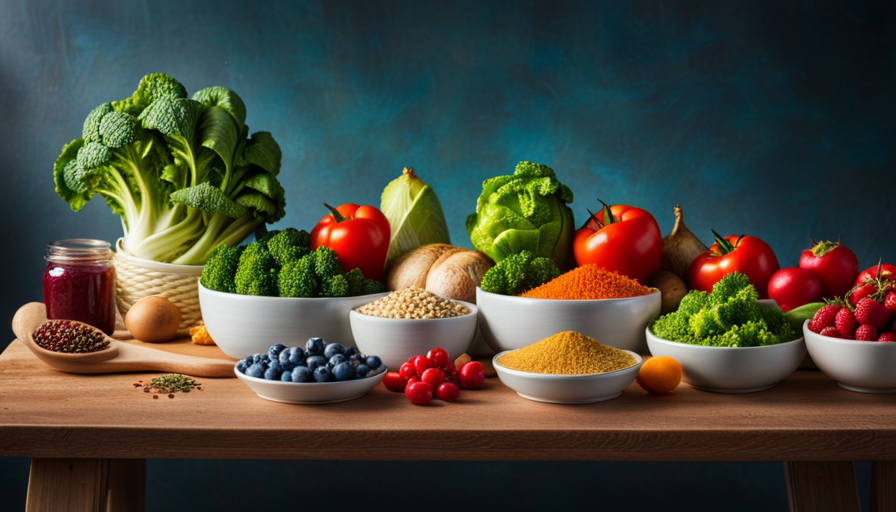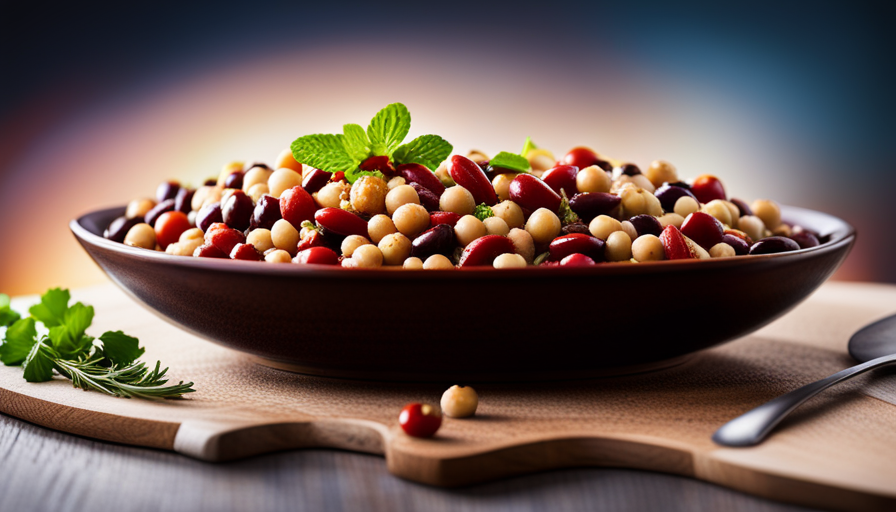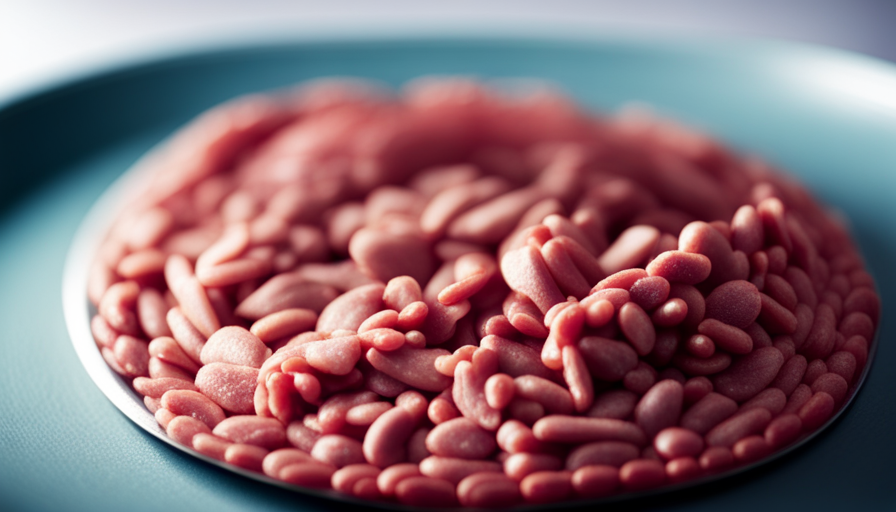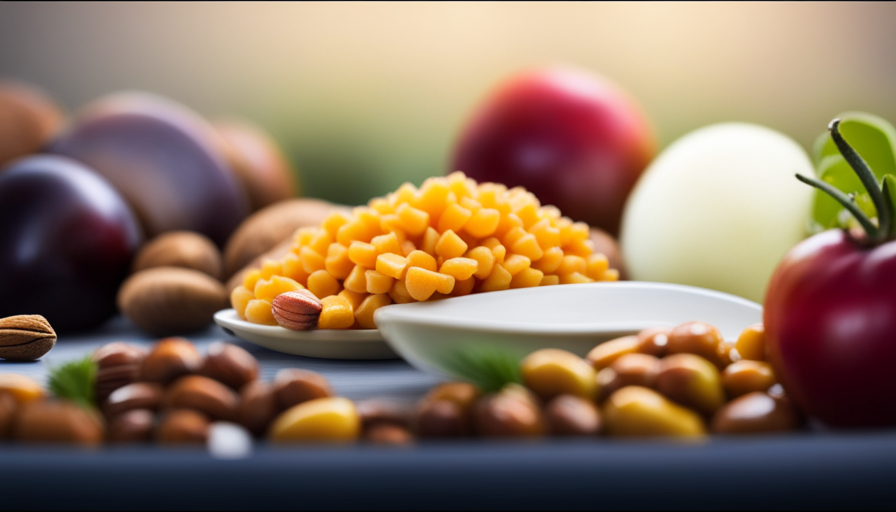Do you enjoy eating raw foods? Although they come packed with a variety of health advantages, there’s a chance you’re inadvertently ingesting elevated quantities of oxalates. These compounds, which occur naturally, have the potential to cause kidney stones and additional health problems if they’re not appropriately controlled. However, fear not, we’re here to help!
In this article, we will show you how to effectively reduce oxalates when eating raw food. By following these evidence-based techniques, you can enjoy the benefits of a raw food diet while minimizing the risks associated with oxalates.
From choosing low-oxalate raw foods to proper food preparation techniques, we will provide you with practical tips to ensure your raw food journey is both delicious and safe. So, let’s dive in and discover how you can optimize your raw food experience while taking care of your health.
Key Takeaways
- Pair high-oxalate foods with calcium-rich foods to reduce oxalate absorption.
- Cooking or steaming high-oxalate foods helps break down oxalates and reduce crystal-forming potential.
- Choosing low-oxalate raw foods reduces the risk of kidney stones and provides health benefits.
- Proper food preparation techniques (washing, peeling) reduce oxalate content.
Understanding Oxalates in Raw Food
To understand oxalates in raw food, you need to visualize tiny crystal-like compounds that can form in your body and cause health issues. Oxalate absorption is an important factor to consider when consuming raw food, as it can have significant health implications.
Oxalates are naturally occurring substances found in many fruits, vegetables, and nuts. When consumed, oxalates can bind with calcium in your body and form crystals that can accumulate in the kidneys or other parts of the urinary tract. This can lead to the formation of kidney stones, a painful condition that affects millions of people worldwide.
Reducing oxalate absorption when eating raw food can be achieved through a few simple strategies. First, consider pairing high-oxalate foods with calcium-rich foods. Calcium can bind with oxalates in the digestive system, preventing their absorption into the bloodstream. For example, if you’re enjoying a spinach salad, try adding some cheese or yogurt to increase your calcium intake.
Another strategy is to cook or steam high-oxalate foods before consuming them. Cooking can help break down the oxalates, making them less likely to form crystals in your body. So, if you’re planning on incorporating raw food into your diet, consider lightly cooking or steaming high-oxalate vegetables like spinach or kale.
By understanding the role of oxalates in raw food and implementing these strategies, you can reduce the risk of oxalate-related health issues and enjoy the benefits of a raw food diet.
Choosing Low-Oxalate Raw Foods
When choosing raw ingredients, focus on low-oxalate options to ensure a healthier diet. Incorporating low oxalate foods into your meals can help reduce the risk of kidney stones and provide numerous health benefits. One way to enjoy low oxalate foods is by making delicious smoothies.
Here are a few low oxalate smoothie recipes that you can try.
First, the Berry Blast Smoothie. Blend together a cup of blueberries, half a cup of strawberries, a cup of almond milk, and a handful of spinach. This smoothie isn’t only low in oxalates but also packed with antioxidants and vitamins.
Next, the Tropical Paradise Smoothie. Combine half a cup of pineapple, half a cup of mango, a cup of coconut water, and a handful of kale. This refreshing smoothie isn’t only low in oxalates but also rich in fiber and immune-boosting nutrients.
Lastly, the Green Goddess Smoothie. Blend together a cup of cucumber, a cup of spinach, a stalk of celery, a tablespoon of lemon juice, and a cup of coconut water. This low oxalate smoothie is perfect for detoxifying and hydrating your body.
Incorporating low oxalate smoothies into your diet can help you reap the benefits of a low oxalate diet, such as reducing the risk of kidney stones and promoting overall health. Enjoy these delicious and nutritious smoothies as part of your raw food journey.
Proper Food Preparation Techniques
One key aspect of maintaining a healthy diet is ensuring that you properly prepare your meals. When it comes to reducing oxalates in raw foods, proper food preparation techniques can play a crucial role.
Not only do these techniques help enhance food safety, but they also preserve the nutritional benefits of the raw ingredients.
To start, it’s important to thoroughly wash all raw fruits and vegetables before consuming them. This helps remove any potential contaminants and reduces the risk of foodborne illnesses. Additionally, peeling the skin of certain fruits and vegetables can further reduce oxalate content. For example, peeling the skin off of cucumbers or zucchini can help decrease the oxalate levels found in these foods.
Another effective technique is blanching. By briefly immersing raw vegetables in boiling water and then immediately placing them in an ice bath, you can reduce oxalate levels while maintaining their nutritional value. Blanching helps break down oxalates, making them less concentrated in the final dish.
By following these proper food preparation techniques, you can minimize oxalate content in raw foods while still enjoying their nutritional benefits. Remember, food safety should always be a priority, and these methods can help you achieve a healthier and tastier raw food diet.
Combining Raw Foods for Oxalate Reduction
By combining a variety of fresh fruits and vegetables, you can create a vibrant and colorful plate that promotes a healthier and tastier diet. When it comes to reducing oxalates in your raw food diet, it’s important to consider the combinations of foods you eat.
Certain combinations can actually help reduce the absorption of oxalates in your body. One effective strategy is to pair high-oxalate foods with foods that are high in calcium. Calcium binds with oxalates in the digestive system, preventing their absorption into the bloodstream. For example, you can combine spinach, which is high in oxalates, with calcium-rich foods such as broccoli or sesame seeds. This will help reduce the oxalate content of the meal.
Another helpful tip is to include foods that are high in magnesium. Magnesium can also bind with oxalates and prevent their absorption. Foods like avocados, bananas, and almonds are excellent sources of magnesium and can be easily incorporated into your raw food combinations.
In addition to calcium and magnesium, it’s important to include foods that are high in vitamin C. Vitamin C helps convert oxalates into a less harmful form, reducing their potential negative impact on your body. Citrus fruits, strawberries, and bell peppers are all great sources of vitamin C and can be combined with other raw foods to create delicious and nutritious meals.
By being mindful of your raw food combinations and incorporating calcium, magnesium, and vitamin C-rich foods, you can effectively reduce the absorption of oxalates in your body and promote a healthier lifestyle.
Soaking and Sprouting Raw Foods
Unlock the full potential of your vibrant plate and nourish your body by embracing the transformative power of soaking and sprouting your fresh fruits and vegetables. Soaking and sprouting are simple techniques that can help reduce oxalate levels in raw foods, making them easier to digest and maximizing their nutritional value.
Here are five benefits and techniques to consider:
-
Increased nutrient availability: Soaking raw foods helps break down anti-nutrients like phytic acid, which can inhibit nutrient absorption. This process increases the availability of essential vitamins and minerals.
-
Improved digestion: Soaking and sprouting can help neutralize enzyme inhibitors and reduce the levels of oxalates, making raw foods more easily digestible and reducing the risk of digestive discomfort.
-
Enhanced flavor and texture: Soaking can improve the texture of certain raw foods, making them softer and more enjoyable to eat. Sprouting can add a subtle nutty flavor, enhancing the taste of your dishes.
-
Reduced antinutrient content: Soaking and sprouting can help reduce the levels of antinutrients like oxalates and lectins, which can interfere with mineral absorption and contribute to inflammation.
-
Increased enzyme activity: Sprouting activates enzymes in raw foods, which can increase their nutrient content and make them easier to digest.
By incorporating soaking and sprouting techniques into your raw food preparations, you can optimize their nutritional benefits and reduce oxalate levels, promoting better digestion and overall health.
Incorporating Calcium-Rich Foods in Your Diet
Boost your health and tantalize your taste buds by adding calcium-rich foods to your daily diet. Calcium is an essential mineral that plays a vital role in maintaining strong bones and teeth, as well as supporting proper muscle and nerve function. When it comes to reducing oxalates in your raw food diet, incorporating calcium-rich foods is key.
One way to increase your calcium intake is through calcium supplements. These can be especially beneficial for those who follow a vegan or plant-based diet, as they may have limited access to traditional dairy sources of calcium. Look for supplements that contain calcium citrate or calcium carbonate, as these’re more easily absorbed by the body.
In addition to supplements, there’re several vegan calcium sources that can be incorporated into your raw food diet. Leafy greens such as kale, collard greens, and spinach are excellent options, as they’re not only rich in calcium but also low in oxalates. Other plant-based sources of calcium include almonds, sesame seeds, and tofu.
By including calcium-rich foods in your raw food diet, you can support your overall health while also reducing oxalate levels. So go ahead and explore the diverse range of vegan calcium sources available, and enjoy the benefits of a nutrient-rich and oxalate-conscious diet.
Monitoring Portion Sizes
Make sure you keep an eye on how much you’re eating to effectively manage your portion sizes. Portion control is an important aspect of reducing oxalates when eating raw food. By monitoring your portion sizes, you can better regulate the amount of oxalates you consume, which can help prevent kidney stone formation and other health issues associated with high oxalate levels.
One way to practice portion control is through meal planning. By planning your meals in advance, you can ensure that you are consuming the right amount of oxalate-rich foods while still maintaining a balanced diet. Include a variety of calcium-rich foods in your meals to help bind with oxalates and prevent their absorption.
Another strategy for portion control is to use smaller plates and bowls. Research has shown that using smaller dishware can trick your brain into feeling more satisfied with smaller portions. This can be particularly beneficial when eating raw foods, as they tend to have higher oxalate levels compared to cooked foods.
Remember to listen to your body’s hunger and fullness cues. Eating slowly and mindfully can help you recognize when you are satisfied and prevent overeating. By practicing portion control and meal planning, you can effectively reduce oxalates when eating raw food and promote overall health and well-being.
Managing Oxalate Intake with Variety
Diversifying your menu with a range of nutrient-rich options can help you navigate the challenge of managing oxalate intake. By incorporating a variety of foods into your meals, you can enjoy the benefits of different nutrients while also reducing the overall oxalate content.
Here are five ways to manage your oxalate intake with variety:
-
Include a mix of low-oxalate fruits and vegetables: Incorporate a variety of low-oxalate options such as berries, cucumbers, bell peppers, and cauliflower into your meals. These options aren’t only low in oxalates but also provide essential vitamins and minerals.
-
Try different protein sources: Experiment with different protein sources like legumes, tofu, and lean meats. This variety ensures that you’re getting a range of nutrients while minimizing oxalate intake.
-
Explore alternative grains: Instead of relying solely on high-oxalate grains like wheat or rice, try incorporating alternatives like quinoa, millet, or buckwheat. These grains offer a different nutrient profile and can help reduce oxalate intake.
-
Mix up your dairy choices: Instead of consuming large amounts of high-oxalate dairy products like cheese, incorporate low-oxalate options such as yogurt or cottage cheese. This variety allows you to enjoy dairy’s benefits while keeping oxalate levels in check.
-
Plan your meals ahead: By planning your meals in advance, you can ensure that you’re incorporating a wide range of foods into your diet. This approach helps you maintain variety while also managing oxalate intake effectively.
Incorporating variety into your meals not only helps reduce oxalate intake but also ensures a well-rounded and nutritious diet. By following these tips and planning your meals accordingly, you can successfully manage oxalates while enjoying a diverse range of flavors and nutrients.
Seeking Professional Guidance and Advice
If you’re looking for expert guidance and advice, consulting with a healthcare professional can provide valuable insights on managing your oxalate intake. Seeking professional support is beneficial because healthcare professionals have the knowledge and experience to help you make dietary adjustments that suit your specific needs.
A healthcare professional can assess your current diet and provide personalized recommendations to reduce oxalates in your raw food diet. They can analyze your overall health, lifestyle, and any specific conditions you may have to create a plan that works best for you. They can also help you understand the importance of variety in your diet and guide you in choosing alternative foods that are lower in oxalates.
Moreover, a healthcare professional can educate you about the factors that contribute to oxalate formation in the body and provide evidence-based strategies to minimize oxalate absorption. They can also suggest cooking techniques and food combinations that can reduce oxalate content in your meals.
In addition to dietary adjustments, a healthcare professional can monitor your progress and make necessary modifications to ensure you are on the right track. They can also offer support and motivation throughout your journey to help you achieve your goals.
Remember, consulting with a healthcare professional is an essential step in effectively managing your oxalate intake when following a raw food diet. Their expertise and guidance can help you make informed decisions and create a balanced and nourishing eating plan.
Listening to Your Body’s Needs
Listening to your body’s needs can provide valuable insights on how to create a balanced and nourishing diet that aligns with your specific nutritional requirements. Body awareness is key when it comes to reducing oxalates while eating raw food.
Being in tune with your body can help you identify any negative reactions or symptoms that may indicate a high oxalate intake. Intuitive eating is a practice that encourages you to listen to your body’s hunger and fullness cues, as well as its cravings and preferences.
When it comes to reducing oxalates, intuitive eating can help guide your food choices. Pay attention to how your body responds to different raw foods. If you notice discomfort or digestive issues after consuming certain foods, it may be a sign that they are high in oxalates and should be limited or avoided.
Additionally, it’s important to remember that everyone’s tolerance to oxalates varies. While some individuals may need to significantly reduce their oxalate intake, others may not have the same sensitivity. By listening to your body and being aware of its needs, you can create a raw food diet that is both enjoyable and beneficial for your overall health.
Frequently Asked Questions
Can I still eat raw spinach if I am trying to reduce oxalate intake?
Yes, you can still enjoy raw spinach if you’re trying to reduce your oxalate intake. While spinach does contain oxalates, it also provides numerous health benefits.
If you have kidney stones, it’s essential to consult with a healthcare professional who can provide personalized advice. However, incorporating a raw food diet can potentially help with kidney stones, as it often includes nutrient-dense foods that promote overall kidney health.
How can I incorporate calcium-rich foods into my raw food diet?
To incorporate calcium-rich foods into your raw food diet, there are plenty of alternatives to dairy that you can consider. Include foods like almonds, sesame seeds, chia seeds, kale, broccoli, and oranges in your meals. These foods are packed with calcium and can help meet your daily requirements.
Calcium is crucial for bone health, nerve function, and muscle contraction, so it’s important to ensure you’re getting enough in your diet.
Are there any specific raw food combinations that can help reduce oxalates?
Oxalate reducing enzymes aren’t present in raw foods, but cooking can significantly reduce oxalate content in certain foods. For example, boiling spinach can reduce its oxalate content by 30-87%. So, incorporating lightly cooked or steamed vegetables into your raw food diet can help lower oxalate intake.
Additionally, pairing high-oxalate foods with calcium-rich ones can help bind oxalates in the gut, reducing their absorption.
What are some common symptoms of consuming high oxalate foods?
Common symptoms of consuming high oxalate foods include kidney stones, which can cause severe pain in your lower back, abdomen, or groin. You may also experience frequent urination, cloudy or bloody urine, and a burning sensation while urinating.
Other symptoms can include digestive issues like diarrhea, nausea, and vomiting.
It’s important to be aware of these symptoms and consult with a healthcare professional if you suspect oxalate-related issues.
Is it necessary to soak or sprout raw foods to reduce oxalate content?
Soaking and sprouting raw foods can be beneficial in reducing oxalate content. Soaking nuts, seeds, and grains in water for a few hours or overnight can help to break down oxalates and make them more bioavailable.
Sprouting techniques, such as germination, can also decrease oxalate levels by activating enzymes that break down oxalates.
Incorporating these methods into your raw food preparation can help reduce the oxalate content and promote better overall health.
Are Oxalates Found in Raw Foods and How Can They Be Reduced?
Yes, oxalates are found in raw foods, especially in leafy greens, nuts, and seeds. To reduce oxalate levels, consider boiling or steaming your vegetables, as this can help decrease the oxalate content. Additionally, pairing high-oxalate foods with calcium-rich options can lower the impact of oxalates in the body, thus reducing the detecting raw food points.
Will Adding Taurine to Raw Food Help Reduce Oxalates?
Supplementing taurine in raw food may not directly reduce oxalates, but it can support overall urinary health. Taurine has been shown to prevent the formation of certain kidney stones, which may have a positive impact on oxalate levels. It’s important to consult a veterinarian before making any dietary changes.
Conclusion
So there you have it! By understanding the role of oxalates in raw food and making informed choices about your diet, you can effectively reduce your oxalate intake.
Remember to properly prepare your raw foods, combine them strategically, and consider soaking and sprouting to further lower oxalate levels.
Keep an eye on portion sizes and vary your food choices to manage oxalate intake.
And most importantly, listen to your body’s needs and seek professional guidance when needed.
Are you ready to take control of your oxalate intake and enjoy the benefits of a raw food diet?










